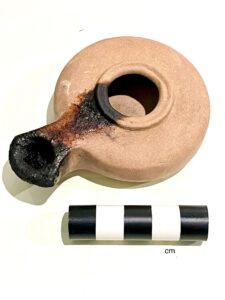The Reference Desk | What Is Biblical Archaeology?
April 24, 2024BruceDayneHave you ever watched a movie without actually watching the movie? I have. You may know what I mean. It is when you’ve watched several different scenes of the movie in short reels embedded in your internet scrolling. Even though you haven’t watched the entire movie in one sitting, you can still piece together the bits you’ve seen and get a general idea of the storyline.
It is much like this when archaeologists try to understand how past cultures lived and functioned. A complete picture of an ancient setting is rarely uncovered, so archaeologists have the daunting task of meticulously excavating. This process involves painstakingly removing layers of soil, taking numerous snippets of information, and understanding how all the data fits together to develop a more complete picture of the ancient site’s history.
The quest to understand ancient people and their setting is why many people love archaeology. Behind every discovery of an artifact, coin, text, and ruins, there is a connection to an ancient person. This connection to the past is what fuels my love for archaeology. Connected to every ancient person is a culture and setting, and when multiplied, it produces civilizations. Archaeology is about connecting the discoveries to a broader setting to gain knowledge about the historical context of a given people or event. In a nutshell, archaeology is the study of ancient man by modern man.
What is biblical archaeology?
As we study the times of the Bible, we depend on biblical archaeology to refine our understanding of the cultures and people recorded in our Bible. To best understand the definition of biblical archaeology, let’s look at the two words separately. As already stated, archaeology is the science of studying ancient mankind through excavations. By adding a filter of biblical settings to archaeology, we limit the focus to only include the Bible’s land, people, and time periods. Also, biblical archaeologists include the information in the Bible as a primary resource. The field of biblical archaeology focuses on the settings and periods depicted in the Bible. The geographical area of study called the Holy Land encompasses significant portions of the Ancient Near East and spans the time period of both the Old Testament and the New Testament. Overall, the insights discovered from biblical archaeology are invaluable as a tool for reinforcing the Bible’s validity and enhancing our understanding of its historical context.
Does biblical archaeology prove the Bible is true?
Archaeologists excavate the land to uncover specific data. The material unearthed cannot be manipulated; the type of pottery found in the ground is what it is. A good archaeologist seeks to discover the truth revealed in the soil. Biblical archaeologists apply these principles to excavation sites in the Holy Land.
A major benefit of biblical archaeologists is their insight into biblical knowledge and literacy. A trained biblical archaeologist recognizes biblical names of locations, people, and artifacts to better understand the truth of what is being uncovered. Ultimately, archaeologists are looking for truth, but they usually find more questions.
Because archaeology often lacks definitive answers, we should therefore not look to biblical archaeology to prove if the Bible is true or not. As Christians, our faith is in the Word of God as the source of truth. 2 Timothy 3:16a reminds us that “All Scripture is inspired by God …” The Bible is truth, and the discipline of archaeology enables us to understand that truth better.
Take, for example, the artifact known as the Tel Dan Stele (a stele is a type of stone plaque). Before its discovery, there was no physical evidence outside of the Bible of the existence of King David. Biblical critics questioned how a key figure in Israel’s history would not be mentioned in any of the surrounding people groups’s ancient texts. The Tel Dan stele “proved that King David from the Bible was a genuine historical figure and not simply the fantastic literary creation of later Biblical writers and editors.”1
Biblical archaeology is a tool that helps validate the Bible, but it is not needed to prove the truth of God’s Word. There may be instances where the findings of archaeology and the Bible differ. In those instances, we choose to believe the Bible and trust God to reveal how the data should be best understood. Ultimately, the Bible stands alone as true.
Why does historical context matter?
Biblical archaeology is a crucial tool for enhancing our understanding of the historical context or setting. This understanding is necessary because we may misinterpret the Bible by projecting our setting and time period onto the text. Biblical archaeology corrects this by allowing us to see the Bible through the eyes of its original audience rather than our modern eyes. Take, for example, the parable of the virgins in Matthew 25:1-13. Jesus tells of ten women with lamps, but only five women brought extra oil to refill their lamps. The lamp and oil are key features in the parable. Being a woman of the 21st century, the idea of needing a lamp for light and extra oil to keep it burning is so foreign to how we live today. If we were to imagine an oil lamp needing to last all night, we might think about the kerosene lanterns used for camping. We would mistakenly attach a lamp from our context to the parable.
According to the archaeological excavations from the setting and time of Jesus’s ministry, the lamp He described would be a small lamp that would fit in a person’s hand. The original audience would all know what lamp Jesus was referring to, and they would all understand how foolish the five women who forgot extra oil were because, of course, the small lamp would not last all night. Through biblical archaeology, we can understand the lamp’s size and even the vessel used for bringing extra oil, which then helps the modern reader better grasp the message of Jesus’s teaching. Something as simple as seeing a visual image of the lamp and container for oil helps the reader understand the parable in a clearer way.
Biblical archaeology illuminates the parable by providing modern context with an ancient oil lamp. Thousands of examples of material objects have been excavated, which gives perspective to the biblical text. Biblical archaeology becomes an object lesson!
Biblical archaeology sifts through the lands of ancient times in search of objects that reveal the setting and activity of people in biblical times. The process of putting pieces together through biblical archaeology helps the audience to gain perspective of historical context and reinforces the Bible’s validity.
Where can you learn more about biblical archaeology?
Thankfully, today, more biblical archaeology resources are available beyond the academic setting.
One of my favorite resources for reading about excavations in the Holy Land is the Biblical Archaeology Review. This is a quarterly magazine that educates the public about important excavations happening in the lands of the Bible.
Another resource is the Armstrong Institute of Biblical Archaeology, which produces a free magazine, Let The Stones Speak.
If you would like to experience an archaeological excavation for yourself, both of the above publications offer a list of digs with which to volunteer.
For formal training in archaeology, New Orleans Baptist Theological Seminary offers a Master of Arts in Biblical Archaeology.
NOBTS also needs volunteers for their summer dig season at Tel Hadid, Israel.
Visit the Museum of the Bible and Archaeology in New Orleans at the New Orleans Baptist Theological Seminary campus for a direct experience viewing the text and artifacts that bring our Bible to life.
To hear Amy teach, check out the Lifeway Women Academy course: The World of the Bible: Historical and Cultural Context 101.
Work Cited
- “Ten Top Discoveries,” Biblical Archaeology Review 35.4 (2009): https://www.biblicalarchaeology.org/daily/biblical-artifacts/the-tel-dan-inscription-the-first-historical-evidence-of-the-king-david-bible-story/.
ABOUT AMY WILLIAMS
Amy Williams is the Director of the Museum of the Bible and Archaeology at New Orleans Baptist Theological Seminary and an Adjunct Instructor for the Thrive Program at Leavell College. She loves to speak about the history of the Bible and the context and background of the Biblical world so women can more deeply experience the joy of God’s Word. She serves alongside her husband, Dr. Tim Williams, at Williams Boulevard Baptist Church. They have served in ministry for over two decades in Canada, South Africa, and Louisiana.
The post The Reference Desk | What Is Biblical Archaeology? appeared first on Lifeway Women.
DMTBeautySpot
via https://dmtbeautyspot.com
Erin Franklin, DMT.NEWS, DMT BeautySpot,




0 comments